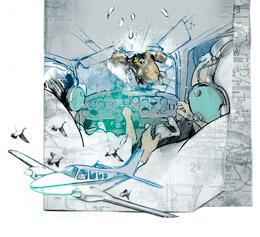Never Again: Unwelcome guests
Night instrument currency takes an unexpected turn
 Listen to this month’s “Never Again” story: The no-nose landing. Download the mp3 file or download the iTunes podcast.
Listen to this month’s “Never Again” story: The no-nose landing. Download the mp3 file or download the iTunes podcast.
Hear this and other original “Never Again” stories as podcasts and download free audio files from our library.
Flight missions require pilots to be up to speed for the type of flight that may be required. Three state law enforcement agencies operate law enforcement aircraft within our state (North Dakota). Any law enforcement issue of significant nature many times will see all three agencies cooperating to solve the case.
That was the case during night instrument recurrent training for two law enforcement pilots for the state of North Dakota. The aircraft was a Baron B55 owned by the North Dakota Attorney General’s Office. On board were Mike Lynk, a Bureau of Criminal Investigation agent, and me—an investigation supervisor and CFI for the North Dakota Game and Fish Department.
The mission this April night was to do instrument approaches in the Bismarck area with Mike in the left seat. The Baron was a former military aircraft obtained via the military law enforcement assistance program, which supplies older aircraft to law enforcement agencies for their missions. N70283’s instrument panel was not in a standard layout. It was not equipped with an autopilot, but had IFR GPS, a horizontal situation indicator (HSI), a standard ILS receiver, and a Bendix/King KNS-80 area navigation system.
The weather was clear, and ground temperature just above freezing. Departing Bismarck, we used airport radar vectors to conduct two ILS procedures for Runway 31. Mike was wearing Foggles. After some basic air work, he flew a third approach followed by a missed approach at Bismarck.
After advising Bismarck Approach of our next request, I asked Mike to set up for a GPS approach to Runway 32 at Hazen and upon departing from the missed approach, climb to 4,500. We stayed in radar contact (Hazen is about 40 miles northwest of Bismarck). Once Mike had the GPS programmed, I gave him back the aircraft. The next task was to set up for the initial approach fix and start a descent for 4,000 feet.
As Mike made the heading change and started descending, I was holding the approach chart, looking down at my lap. As we descended through 4,200 feet, the night exploded.
My vision went black, and I became aware of 155 knots of wind inside the Baron. My first thought was, We hit another airplane!
Fighting to get back my vision, I focused on Mike. Blood was coming down my face. My left eye had a problem, my glasses were gone, and my headset was in pieces. Mike was still wearing his headset and Foggles as he reached for the throttles and pushed them forward.
Now I could see the instruments on my side. Both engines running normally; our airspeed and altitude were good. The windshield was gone! It must have been birds!
I turned the transponder to 7700, then hit ident. Not only was the windshield smashed, but so was the top of the dash. The noise was deafening. Mike hollered, “Where do you want to land?”
My mind was racing. He doesn’t still want to do the approach? I hollered back, “Bismarck, Bismarck,” as I motioned toward the back of the airplane.
Mike could not hear Bismarck Approach either. We were 30 miles north of town. The broken glareshield was flopping in Mike’s face. While holding the left side of my face, with my right hand I reached over and held down the dash out of Mike’s way. He broadcast in the blind to Approach that the aircraft was running fine, but we had lost the windshield and we had injuries. The temperature inside the cabin was probably close to zero.
As we got closer to Bismarck I forced myself to open my left eye and look over the glareshield. I could see, so I still had my eye. At Bismarck, Mike made an uneventful no-flap landing.
We had hit a flock of mallard ducks—two on the right wing, one on the nose, and one inside the cockpit. The Baron’s windshield, dash, and interior had to be replaced. Its right wing required leading edge repair and replacement of the deicing boot.
The emergency room physician sent me for a CT scan. As they prepared me for the procedure, the attending doctor asked what happened. I said I got hit by a duck. He said, “No, what really happened?”
It is somewhat ironic that a career game warden would be taken down by a duck.
Incidents out of the ordinary present pilots with a challenge they might not have considered. Aeronautical decision making, an important part of risk management, normally includes assessment of the likelihood of an event. For those areas where history has shown a high probabilities of a risk occurring, tabletop scenario and simulator reviews help mitigate the risk. When an event happens that is “almost” improbable, the challenge is to identify the problem, assess potential solutions, apply the remedy, and then assess the result. Do not panic; action is required. AOPA
Bruce Burkett has been a pilot for 34 years. He is an ATP and CFII, and has more than 10,500 hours. He retired in February 2013 from a 41-year career in law enforcement in North Dakota.


